
Sparganothis pilleriana, also known as the vine leafroller tortrix, is a moth of the family Tortricidae found in the Palearctic realm. It was first described by the Austrian lepidopterists Michael Denis and Ignaz Schiffermüller in 1775.

Eucosma conterminana, the lettuce tortricid, is a moth of the family Tortricidae.
Blastopetrova is a genus of moths belonging to the subfamily Olethreutinae of the family Tortricidae. It contains only one species, Blastopetrova keteleericola, which is found in China.
Mantua is a monotypic moth genus belonging to the subfamily Tortricinae of the family Tortricidae. The genus was first described by Elwood Zimmerman in 1978. Its only species, Mantua fulvosericea, was first described by Lord Walsingham in 1907. It is endemic to the Hawaiian islands of Kauai, Oahu, Molokai and Lanai.
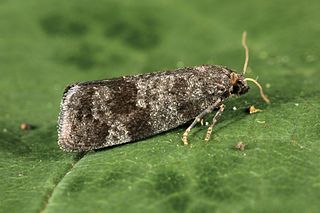
Neosphaleroptera is a genus of moths belonging to the subfamily Tortricinae of the family Tortricidae. It contains only one species, Neosphaleroptera nubilana, which is found in almost all of Europe and the Near East.
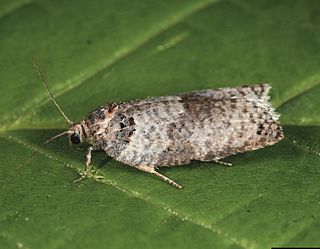
Pseudeulia is a genus of moths belonging to the subfamily Tortricinae of the family Tortricidae. It contains only one species, Pseudeulia asinana, which is found in Italy, Slovenia, Austria, the Czech Republic, Slovakia, Hungary, Romania, Bulgaria, North Macedonia and Ukraine.
Synnoma is a genus of moths belonging to the subfamily Tortricinae of the family Tortricidae. It contains only one species, the rabbitbrush webbing moth, which is found in North America, including Arizona.

Epinotia nanana, the European spruce needleminer, is a moth of the family Tortricidae. It is found from northern and central Europe to Russia and Mongolia.

Cydia duplicana is a small moth of the family Tortricidae. It is found in all across Europe, extending barely into Asia in the Transcaucasus, Turkestan and Kazakhstan.
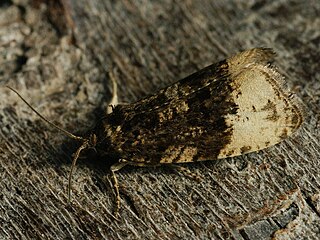
Hedya ochroleucana, the buff-tipped marble or long-cloaked marble, is a moth of the family Tortricidae. It is found in most of Europe, except part of the Balkan Peninsula and Ukraine and east across the Palearctic. It is also present in most of North America.
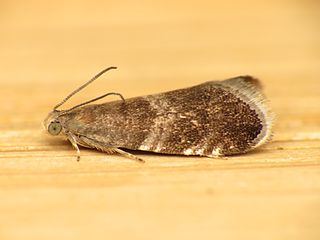
Strophedra weirana, the little beech piercer, is a moth of the family Tortricidae. It is found in most of Europe, except the Iberian Peninsula, part of the Balkan Peninsula, Ukraine, the Baltic region, Finland and Ireland.

Endothenia pauperculana is a moth of the family Tortricidae. It is found in France, Switzerland, Italy, Portugal, Spain and on Sardinia and the Canary Islands.
Argyrotaenia sphaleropa is a species of moth of the family Tortricidae. It is found in South America, where it has been recorded from Colombia, Bolivia, Brazil, Peru, Uruguay and Argentina.
Choristoneura biennis, the two-year-cycle budworm moth, is a species of moth of the family Tortricidae. It is found in Canada, where it has been recorded from Alberta and British Columbia.
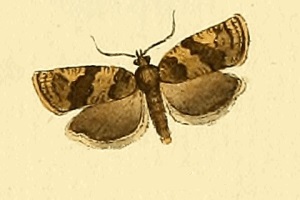
Choristoneura diversana is a species of moth of the family Tortricidae. It is found in Great Britain, France, Belgium, the Netherlands, Germany, Denmark, Austria, Switzerland, Italy, the Czech Republic, Slovakia, Slovenia, Poland, Bulgaria, Hungary, Romania, Norway, Sweden, Finland, the Baltic region, Russia and the Near East. In the east, the range extends to China (Heilongjiang), Korea and Japan. The habitat consists of gardens, scrub and fens.

Choristoneura lafauryana, the strawberry leafroller, is a species of moth of the family Tortricidae. It is found in Spain, Great Britain, the Netherlands, Belgium, France, Germany, Switzerland, Italy, Romania and Russia. In the east, the range extends to China, Korea and Japan.

Choristoneura evanidana is a species of moth of the family Tortricidae. It is found in the Russian Far East, Korea and China.

Choristoneura longicellanus is a species of moth of the family Tortricidae. It is found in China, Japan, Taiwan, the Korean Peninsula and the Russian Far East.
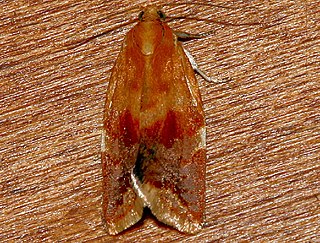
Clepsis persicana, the white triangle tortrix or the green needleworm, is a species of moth of the family Tortricidae. It is found in North America, where it has been recorded from Alaska and British Columbia to Newfoundland and south to Virginia and west to California. The habitat consists of coniferous and mixed coniferous forests.

Ptycholomoides aeriferana, the larch twist, is a species of moth of the family Tortricidae. It is found in China (Heilongjiang), the Korean Peninsula, Japan, Russia and most of Europe.













